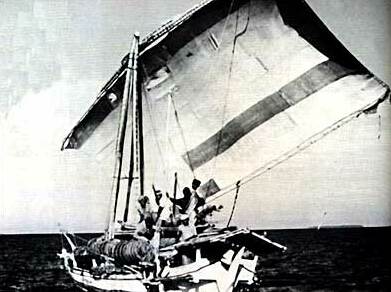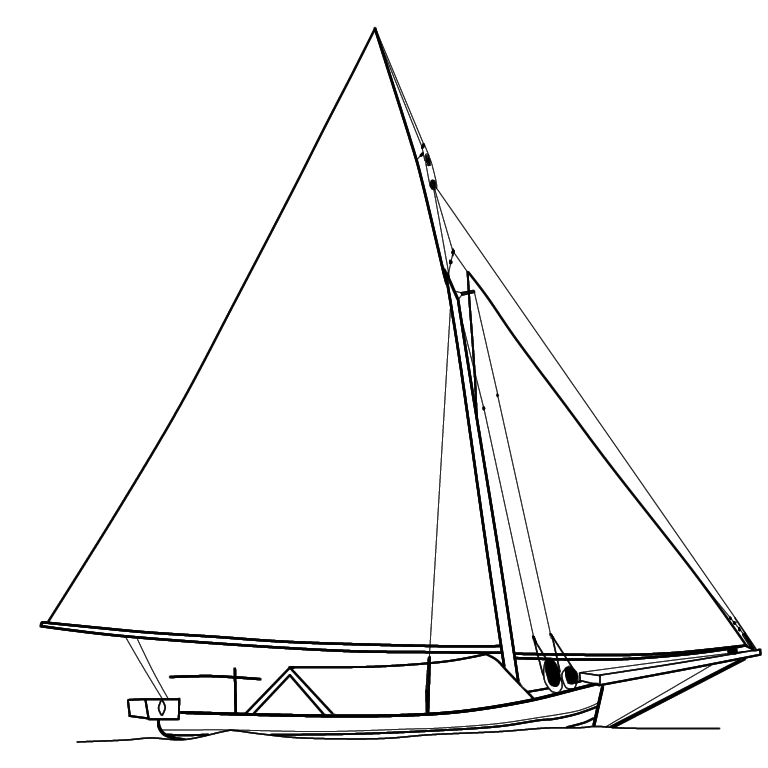|
Palari (boat)
Palari is a type of Indonesian sailing vessel from South Sulawesi. It was mainly used by the people of Ara and Lemo Lemo, for transporting goods and people. This vessel is rigged with pinisi rig, which often makes it better known as "Pinisi" instead of its name. In Singapore, palari is known as "Makassar trader". Etymology The name of this boat comes from Bugis word ''lari'' meaning "to run" or "running". The word ''pa'' is a suffix used in forming nouns designating persons from the object of their occupation or labor, equivalent to English -or/-er, so the meaning of ''palari'' would be "runner". This refers to the fact that this vessel is nimbler and faster than its predecessor, the padewakang.Vuuren, L. Van 1917. 'De Prauwvaart van Celebes'. ''Koloniale Studien'', 1,107-116; 2, 329-339, pg. 108. Description Palari is about 50–70 feet (15.24–21.34 m) in length overall, with light laden waterline of 34–43 feet (10.36–13.1 m). The sails are built using light canvas, w ... [...More Info...] [...Related Items...] OR: [Wikipedia] [Google] [Baidu] |
Leti Leti
Leti leti is a type of traditional transport vessel from East Madura, Indonesia, especially from the administrative district of Sumenep. The leti leti is a recent development, the hull form and sail were developed in the 19th century. In 1979 sailing leti leti was numbered about 1000, but this was reduced in the next decades when more modern, motorized vessel appeared.Horridge (2015). p. 82. Etymology Leti leti is also known with other names and pronunciation, like leti-leti, letelete, lete lete, letek-letek, leteh-leteh, parao lete', and golekan lete. The origin of the name is unknown. In early 20th century the type was referred to in different publications as ''tekletek''. This is however the same name, with the first syllable dropped: 'le'''tek-letek'', as in 'a'''lisalis''. It may also possible that the name comes from the sail it used, the Madurese crab claw sail, or lete sail, which has just developed in the 19th century. In fact, the "lete" from lete sail is a local pronu ... [...More Info...] [...Related Items...] OR: [Wikipedia] [Google] [Baidu] |
Ship Types
A ship is a large watercraft that travels the world's oceans and other sufficiently deep waterways, carrying cargo or passengers, or in support of specialized missions, such as defense, research, and fishing. Ships are generally distinguished from boats, based on size, shape, load capacity, and purpose. Ships have supported exploration, trade, warfare, migration, colonization, and science. After the 15th century, new crops that had come from and to the Americas via the European seafarers significantly contributed to world population growth. Ship transport is responsible for the largest portion of world commerce. The word ''ship'' has meant, depending on the era and the context, either just a large vessel or specifically a ship-rigged sailing ship with three or more masts, each of which is square-rigged. As of 2016, there were more than 49,000 merchant ships, totaling almost 1.8 billion dead weight tons. Of these 28% were oil tankers, 43% were bulk carriers, and 13% were con ... [...More Info...] [...Related Items...] OR: [Wikipedia] [Google] [Baidu] |
Janggolan
Janggolan refers to two different type of ''perahu'' from Indonesia. One is from Madura, and the other from Bali. The Madurese janggolan is a type of indigenously constructed boat, meanwhile Balinese janggolan is an indigenous boat with western-styled hull construction. Madurese janggolan Janggolan in Madura comes from the western half of the south coast of Madura, from Kamal to Sampang. It is the largest from the family of boats with double stempost, like lis-alis. They can be found plying to Singapore in the past, being called "old-style golekkan". Etymology The word ''janggolan'' means transportation.Horridge (2015). p. 69. It is also called as ''parao janggol'' (meaning "transport perahu") by the Madurese. Like the alisalis, janggolan were regarded as "female" (''parao bini'' — female boat), and ornamental motif used were connected with the feminine.Stenross (2007). p. 277. Description Madurese janggolan can be identified by flat decorated face between the double stemp ... [...More Info...] [...Related Items...] OR: [Wikipedia] [Google] [Baidu] |
Lis-alis
Lis-alis is a type of traditional boat of Madura, Indonesia. Lis-alis usually present in canals that provide salt evaporation service in southern part of Madura and around Surabaya. Until the present, lis-alis remained overwhelmingly popular as a fishing craft in Bangkalan and Sukolilo, while a larger version, the '' kroman'', has been used in this area for at least a century for inshore transport work. Etymology It is also known as alisalis or alis alis. The name come from Indonesian word ''alis'' which means "eyebrows". This may refer to an ornamental motif which does resemble a pair of eyebrows, often applied to the top of the bow. Eyebrows are an important aspect of feminine beauty in traditional Indonesian culture, and these boats strongly associated with the feminine — on the northwest coast they were commonly referred as ''parao bini'', which means "female boat". Description These boats come from varying size between 5 metres long to more than 10 metres. Usually the le ... [...More Info...] [...Related Items...] OR: [Wikipedia] [Google] [Baidu] |
Patorani
Patorani (also prauw patorani or perahu patorani) is a traditional fishing boat from Makassar, Indonesia. It is used by Macassan people for fishing, transport, and trading since at least 17th century A.D. Historically this type of boat was used by Gowa Sultanate as war boat. Etymology The name "torani" means flying fish (Exocoetidae).Horridge (2015). p.17 Patorani can be translated as "flying fish catcher". Description Patorani fishing boat has pajala type hull with Makassar-styled rudder mounting and tripod mast. The second tripod mast is supported by the roof of its deckhouse. This boat carried wood poles as a material for fishing and basket-shaped fish traps. The sail is usually canted rectangular sail or lateen sail. Some of them had bowsprit, adorned with pieces of wool, pendants, wooden fish carving, and other decorations. If the bowsprit is not present, they are placed in the curved stempost. Patorani design remains largely unchanged for several hundred years, but someti ... [...More Info...] [...Related Items...] OR: [Wikipedia] [Google] [Baidu] |
Padewakang
Padewakang were traditional boats used by the Bugis, Mandar, and Makassar people, Makassar people of South Sulawesi. Padewakang were used for long distance voyages serving the south Sulawesi kingdoms. Etymology No-one quite seems to know the origin of the name ''padewakang,'' though some have suggested that it stems from Dewakang Island, an important navigational landmark between Sulawesi and Java. Dutch records from the 1735 mention letters from Sulawesi arriving in Batavia ‘per praauw Paduackang’. According to Horridge, the words ''padewakang'', ''paduwakang'' (Sulawesi) and ''paduwang'' (Madura Island, Madura) have its roots from word ''wa'', ''wangka'', ''waga'', ''wangga'', and ''bangka'' of Austronesian languages. The term is associated with outrigger perahu or small perahu. Description It typically weights between 20 and 50 tons, had one or two tripod masts with "lateen" (tanja sail, tanja) sails made of mat. Like other traditional vessels of the archipelago, it i ... [...More Info...] [...Related Items...] OR: [Wikipedia] [Google] [Baidu] |
Lambo (boat)
The term lambo or lamba refer to two types of traditional boats from Indonesia. Butonese lambo Lambo is the Indonesian version of small western styled merchant boats with one mast from the end of the 19th century. It is directly developed as merchant boats, and unlike other boats from Indonesia, it was not derived from local fishing ''perahu'' or canoe.Horridge (2015). p. 125. Etymology The origin of the word "lambo" and its meaning is not clear. It is probable that this word is a crude dialog word meaning ''no mother", which means this boat doesn't incorporate ancestor traditions (that is, developed from Western boats). It may also be possible that, the word comes from Kawi language, Kawi (Old Javanese) language word "lambu" which means a kind of boat. Description It has two masts, with its sturdy rig and Gaff rig, gaff easily recognized from afar. The defining features of this boat is the shape of the keel, bow, and the stern (it has "counter" type stern). Most of them ... [...More Info...] [...Related Items...] OR: [Wikipedia] [Google] [Baidu] |
Indonesian National Revolution
The Indonesian National Revolution, or the Indonesian War of Independence, was an armed conflict and diplomatic struggle between the Republic of Indonesia and the Dutch Empire and an internal social revolution during Aftermath of WWII, postwar and Dutch East Indies#World War II and independence, postcolonial Indonesia. It took place between Indonesian Declaration of Independence, Indonesia's declaration of independence in 1945 and the Netherlands' Dutch–Indonesian Round Table Conference, transfer of sovereignty over the Dutch East Indies to the Republic of the United States of Indonesia at the end of 1949. The four-year struggle involved sporadic but bloody armed conflict, internal Indonesian political and communal upheavals, and two major international diplomatic interventions. Dutch military forces (and, for a while, the forces of the World War II Allies, World War II allies) were able to control the major towns, cities and industrial assets in Republican heartlands on Ja ... [...More Info...] [...Related Items...] OR: [Wikipedia] [Google] [Baidu] |
Jakarta
Jakarta (; , bew, Jakarte), officially the Special Capital Region of Jakarta ( id, Daerah Khusus Ibukota Jakarta) is the capital and largest city of Indonesia. Lying on the northwest coast of Java, the world's most populous island, Jakarta is the largest city in Southeast Asia and serves as the diplomatic capital of ASEAN. The city is the economic, cultural, and political centre of Indonesia. It possesses a province-level status and has a population of 10,609,681 as of mid 2021.Badan Pusat Statistik, Jakarta, 2022. Although Jakarta extends over only , and thus has the smallest area of any Indonesian province, its metropolitan area covers , which includes the satellite cities Bogor, Depok, Tangerang, South Tangerang, and Bekasi, and has an estimated population of 35 million , making it the largest urban area in Indonesia and the second-largest in the world (after Tokyo). Jakarta ranks first among the Indonesian provinces in human development index. Jakarta's busin ... [...More Info...] [...Related Items...] OR: [Wikipedia] [Google] [Baidu] |
Allies Of World War II
The Allies, formally referred to as the United Nations from 1942, were an international military coalition formed during the Second World War (1939–1945) to oppose the Axis powers, led by Nazi Germany, Imperial Japan, and Fascist Italy. Its principal members by 1941 were the United Kingdom, United States, Soviet Union, and China. Membership in the Allies varied during the course of the war. When the conflict broke out on 1 September 1939, the Allied coalition consisted of the United Kingdom, France, and Poland, as well as their respective dependencies, such as British India. They were soon joined by the independent dominions of the British Commonwealth: Canada, Australia, New Zealand and South Africa. Consequently, the initial alliance resembled that of the First World War. As Axis forces began invading northern Europe and the Balkans, the Allies added the Netherlands, Belgium, Norway, Greece, and Yugoslavia. The Soviet Union, which initially had a nonaggression pa ... [...More Info...] [...Related Items...] OR: [Wikipedia] [Google] [Baidu] |
Japanese People
The are an East Asian ethnic group native to the Japanese archipelago."人類学上は,旧石器時代あるいは縄文時代以来,現在の北海道〜沖縄諸島(南西諸島)に住んだ集団を祖先にもつ人々。" () Japanese people constitute 97.9% of the population of the country of Japan. Worldwide, approximately 129 million people are of Japanese descent; of these, approximately 122.5 million are residents of Japan. People of Japanese ancestry who live outside Japan are referred to as , the Japanese diaspora. Depending on the context, the term may be limited or not to mainland Japanese people, specifically the Yamato (as opposed to Ryukyuan and Ainu people). Japanese people are one of the largest ethnic groups in the world. In recent decades, there has also been an increase in the number of multiracial people with both Japanese and non-Japanese roots, including half Japanese people. History Theories of origins Archaeological evidence indi ... [...More Info...] [...Related Items...] OR: [Wikipedia] [Google] [Baidu] |



_atau_Jabaran.png)




